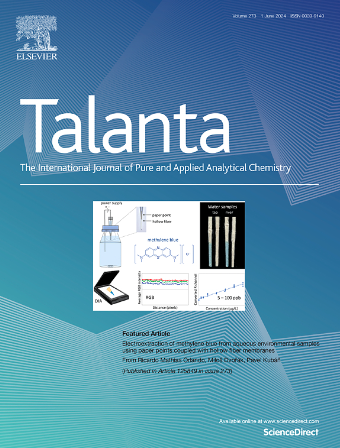TiO2-coated honeycomb-like super-macroporous silica for high-purity extraction of exosomes from human plasma
IF 5.6
1区 化学
Q1 CHEMISTRY, ANALYTICAL
引用次数: 0
Abstract
Screening biomarkers from exosomes has emerged as a new strategy for non-invasive early diagnosis of diseases. Nevertheless, the present screening efficiency and accuracy of biomarkers are limited by the low extraction efficiency and purity of exosomes. To address this issue, a highly selective adsorbent, which integrates size-exclusion and chemisorption, was created by coating TiO2 on honeycomb-like super-macroporous silica. Cell culture medium and human plasma were employed to investigate the enrichment performance, and the results indicate that the super-macropores ranging from 63.5 to 147.5 nm together with thin pore walls allow exosomes to enter and be adsorbed by TiO2 in the pores, enhancing the available surface area for exosomes meanwhile physically excluding the large-sized cell debris and vesicles. Taking advantages of these properties, the prepared adsorbent achieves a higher extraction efficiency, recovery and purity of exosomes compared with the normal adsorbents and ultracentrifugation (UC) method. Combining this method with proteomic analysis, a total of 392 proteins were identified in exosomes from healthy human plasma, which is significantly higher than the number obtained by UC (200 proteins). For clinical samples, 59 upregulated and 124 downregulated proteins were identified in the plasma from colorectal cancer (CRC) patients, of which 44 upregulated proteins and 69 downregulated proteins are strongly associated with the progression of CRC. These findings suggest that this adsorbent possesses considerable potential in the extraction of exosomes for screening biomarkers and diagnosing tumor progress.

求助全文
约1分钟内获得全文
求助全文
来源期刊

Talanta
化学-分析化学
CiteScore
12.30
自引率
4.90%
发文量
861
审稿时长
29 days
期刊介绍:
Talanta provides a forum for the publication of original research papers, short communications, and critical reviews in all branches of pure and applied analytical chemistry. Papers are evaluated based on established guidelines, including the fundamental nature of the study, scientific novelty, substantial improvement or advantage over existing technology or methods, and demonstrated analytical applicability. Original research papers on fundamental studies, and on novel sensor and instrumentation developments, are encouraged. Novel or improved applications in areas such as clinical and biological chemistry, environmental analysis, geochemistry, materials science and engineering, and analytical platforms for omics development are welcome.
Analytical performance of methods should be determined, including interference and matrix effects, and methods should be validated by comparison with a standard method, or analysis of a certified reference material. Simple spiking recoveries may not be sufficient. The developed method should especially comprise information on selectivity, sensitivity, detection limits, accuracy, and reliability. However, applying official validation or robustness studies to a routine method or technique does not necessarily constitute novelty. Proper statistical treatment of the data should be provided. Relevant literature should be cited, including related publications by the authors, and authors should discuss how their proposed methodology compares with previously reported methods.
 求助内容:
求助内容: 应助结果提醒方式:
应助结果提醒方式:


